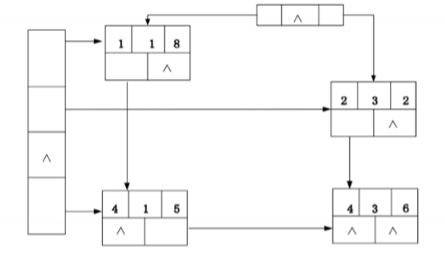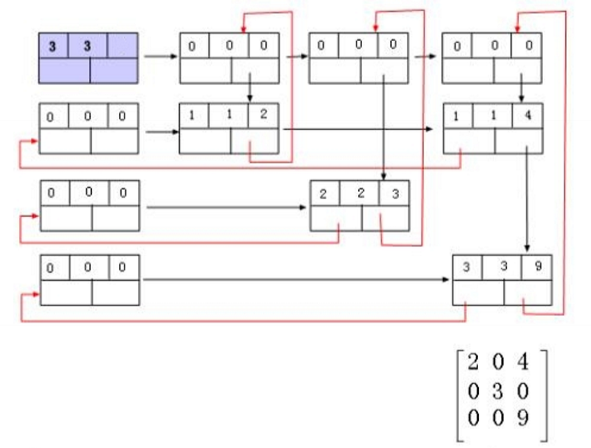published: true
date: 2022-1-22
tags: 'algorithm and data structure'
array
This chapter mainly introduces the basic concept and extension of array, and the storage decoupling of special matrices of two-dimensional array: symmetric matrix, triangular matrix, sparse matrix, cross linked list, etc; Then the fast transpose algorithm of sparse matrix is introduced and implemented.
Can be reproduced, but please state the source link: article source link justin3go.com (some latex formulas cannot be rendered on some platforms. You can view this website.)
array
characteristic:
- Structural fixation
- The elements in each dimension are isomorphic
Array operation:
- Access the corresponding data element at a given location.
- Modify the value of the data element at a given location.
- Arrays are generally not added or deleted.
Array sequential storage:
- Row order is the main order.
L o c ( a i j ) = L o c ( a 00 ) + ( i × n + j ) × L Loc(a_{ij}) = Loc(a_{00}) + (i\times n + j)\times L Loc(aij)=Loc(a00)+(i×n+j)×L
- Column order is the main order.
L o c ( a i j ) = L o c ( a 00 ) + ( j × m + i ) × L Loc(a_{ij}) = Loc(a_{00}) + (j\times m + i)\times L Loc(aij)=Loc(a00)+(j×m+i)×L
Special matrix
symmetric matrix
n = { i ( i + 1 ) / 2 + j , i > = j j ( j + 1 ) / 2 + i , i < j n = \begin{cases} & \text i(i+1)/2+j, i>=j \\ & \text j(j+1)/2+i, i<j \end{cases} n={i(i+1)/2+j,i>=jj(j+1)/2+i,i<j

Triangular matrix
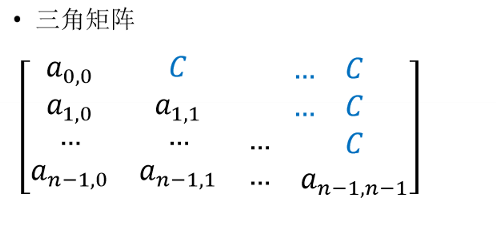
n = { i ( i + 1 ) / 2 + j , i > = j n ( n + 1 ) 2 , i < j n = \begin{cases} & \text i(i+1)/2 + j, i>=j \\ & \text n(n+1)2, i<j \end{cases} n={i(i+1)/2+j,i>=jn(n+1)2,i<j
Tridiagonal matrix
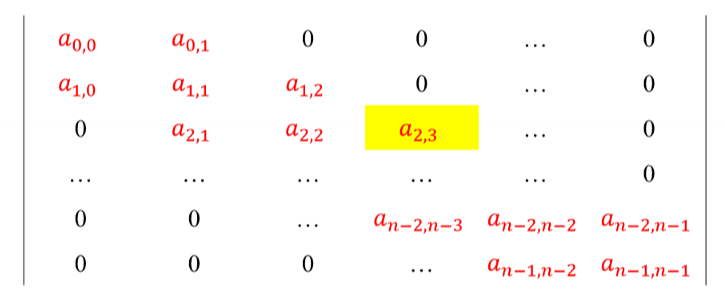
(take the main line order as an example)
- Total length: 3n-2
- Known K (0 < = k < = 3n-3)
- i = (k+1)/3
- j = (k+1)%3+i-1

sparse matrix
definition

- Number of non-zero elements < < number of zero elements
- Irregular distribution
- For matrix M:
- Density = total number of non-zero elements in M / total number of elements in M.
- When density < = 5%, M is called sparse matrix.
- Density is called the density of M.
Compressed storage
- Triple method
- Stores row, column subscripts and their values for non-zero elements.
- Store the row and column dimensions of the matrix.
- Triples: {0, 1, 12}, {0, 2, 9}, {3, 1, - 3}······
- Determinant dimension: (6, 7)
- Number of non-zero elements: 8
| 0 | 6 | 7 | 8 |
|---|---|---|---|
| 1 | 1 | 2 | 12 |
| 2 | 1 | 3 | 9 |
| 3 | 3 | 1 | -3 |
| 4 | 3 | 6 | 14 |
| 5 | 4 | 3 | 24 |
| 6 | 5 | 2 | 18 |
| 7 | 6 | 1 | 15 |
| 8 | 6 | 4 | -7 |
Fast transpose
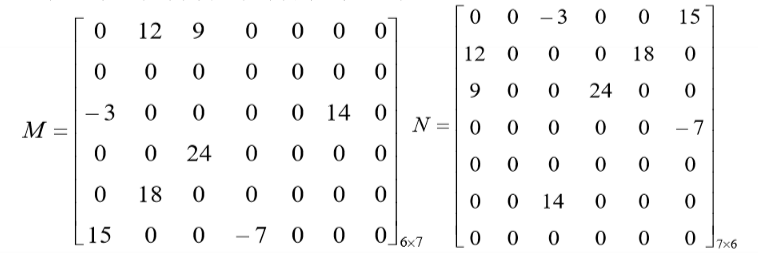
General matrix transpose:
for(col = 0; col < n; col++){
for(row = 0; row < m; row++){
n[col][row] = m[row][col];
}
}
//Time complexity: T(n) = O(mxn)
Quick transpose:
- Transpose in the order of triples in M, and put the transposed result in the appropriate position in N.
- Determine the position of the first non-zero element of each column in M in N.
- To determine these positions, first calculate the number of non-zero elements in each column in M.
- Set two auxiliary arrays
- num[col]: indicates the number of non-zero elements in col column in M.
- cpot[col]: indicates the position of the first non-zero element in col column in M in N.
- Obviously
- cpot[1] = 1
- cpot[col] = cpot[col-1] + num[col-1]; (2<=col<=M[0])
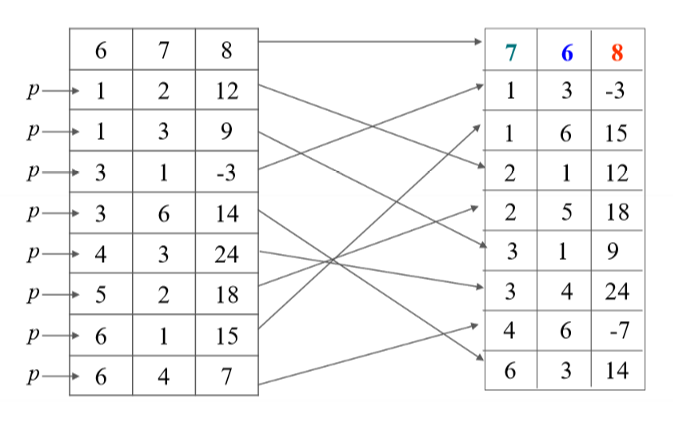

get ready:
#include<iostream>
#include<vector>
#include<cstring>
using namespace std;
int num[5][5] = {
{1,1,1,1,1},
{0,0,0,1,0},
{0,0,1,0,0},
{0,1,0,0,0},
{1,1,1,1,1},
};
Chained storage:
struct elements
{
int col;
int row;
int val;
elements* next;
elements(int col, int row, int val):
col(col),row(row),val(val),next(NULL){}
};
//If you are lazy here, you won't pass in the length. O(∩∩), the global variable defined by the array
void num2elements(elements* head){
elements* temp = NULL;
for(int i = 4; i >= 0; i--){
for(int j = 4; j >= 0; j--){
if(num[i][j] != 0){
temp = new elements(i, j, num[i][j]);
temp->next = head->next;
head->next = temp;
}
}
}
}
CIS storage:
vector<vector<int>> elements;
vector<int> temp;
void num2elements(){//Convert 3 tuples
temp.push_back(5);
temp.push_back(5);
temp.push_back(13);
elements.push_back(temp);
temp.clear();
for(int i = 0; i < 5; i++){
for(int j = 0; j < 5; j++){
if(num[i][j] != 0){
temp.push_back(i);
temp.push_back(j);
temp.push_back(num[i][j]);
elements.push_back(temp);
temp.clear();
}
}
}
}
Transpose operation:
int count[5];
int cpot[5];
int result[14][3];//Results after transposition;
void trans(){
//init count
for(int i = 0; i < elements.size(); i++){
count[elements[i][1]]++;
}
//init cpot
int sum = 0;
for(int i = 0; i < 5; i++){
cpot[i] = sum;
sum += count[i];
}
int index = 0;
for(int i = 1; i < 14; i++){
index = ++cpot[elements[i][1]];
result[index][0] = elements[i][1];
result[index][1] = elements[i][0];
result[index][2] = elements[i][2];
}
//Assign values to rows and columns and non-zero numbers
result[0][0] = elements[0][1];
result[0][1] = elements[0][0];
result[0][2] = elements[0][2];
}
int T_num[5][5];
void print_result(){
memset(T_num, 0, sizeof(T_num));
for(int i = 1; i < 14; i++){
T_num[result[i][0]][result[i][1]] = result[i][2];
}
for(int i = 0; i < 5; i++){
for(int j = 0;j < 5; j++){
cout << T_num[i][j] << ", ";
}
cout << endl;
}
}
Main function:
int main(){
//elements* head = new elements(5, 5, 13);
//num2elements(head);
num2elements();
for(int i = 0; i < elements.size(); i++){
for(int j = 0; j < 3; j++){
cout << elements[i][j] << ", ";
}
cout << endl;
}
cout << "*************************" << endl;
trans();
for(int i = 0; i < 14; i++){
for(int j = 0; j < 3; j++){
cout << result[i][j] << ", ";
}
cout << endl;
}
cout << "*************************" << endl;
print_result();
return 0;
}
result:
/* 5, 5, 13, 0, 0, 1, 0, 1, 1, 0, 2, 1, 0, 3, 1, 0, 4, 1, 1, 3, 1, 2, 2, 1, 3, 1, 1, 4, 0, 1, 4, 1, 1, 4, 2, 1, 4, 3, 1, 4, 4, 1, ************************* 5, 5, 13, 0, 0, 1, 0, 4, 1, 1, 0, 1, 1, 3, 1, 1, 4, 1, 2, 0, 1, 2, 2, 1, 2, 4, 1, 3, 0, 1, 3, 1, 1, 3, 4, 1, 4, 0, 1, 4, 4, 1, */
Orthogonal list
Cause: triplet table element moved
- For sequentially stored triple tables, the time overhead of moving elements is large
- In order to maintain the main row order and column order, more overhead may be incurred
Cross linked list is another storage strategy of sparse matrix
- Each non-zero element is a node, and each node contains five fields.
- Among them, row field i, column field j and value field v represent row subscript, column subscript and value of non-zero elements respectively.
- The right field right links the next non-zero element in the same row.
- The down field down links the next non-zero element in the same column.
- Cross linked list storage requires additional pointer fields, row and column pointers
- Generally, when the number of non-zero elements does not exceed 20% of the total number of elements, it is suitable for cross linked list storage.
